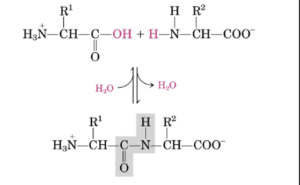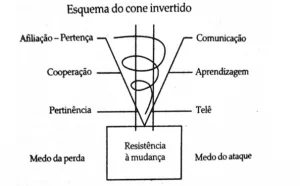ORIGINAL ARTICLE
CANDIDO, Letícia Martins Ribeiro [1]
CANDIDO, Letícia Martins Ribeiro. Psychological Illness and Elementary Education: Social Representations of the Sick Teacher. Revista Científica Multidisciplinar Núcleo do Conhecimento. Year 06, Ed. 04, Vol. 09, pp. 183-202. April 2021. ISSN: 2448-0959, Access link: https://www.nucleodoconhecimento.com.br/psychology/psychological-illness
ABSTRACT
This study is part of the field of school psychology in interface with health psychology and uses the methodology of social representations in its structural approach to identify the social representations of the elementary school teacher about mental health at work. For this, a field research was carried out, using a socio-demographic questionnaire and free recall technique in a municipal school in the metropolitan region of Goiânia-GO with 18 (eighteen) teachers from the municipal public network who were previously diagnosed with some type of psychological disorder. The results indicate that the elements of the peripheral nucleus relate to aspects external to the teacher, that is, elements that can be modified from interventions in the environment or in school culture. The elements present in the central nucleus are linked to the internal aspects of the teacher, that is, they are less flexible elements and that, in order to make any change in these representations, these aspects must be worked on individually and singularly.
Keywords: Illness, Mental Health, Teachers, Social Representations.
1. INTRODUCTION
This study is part of the field of school psychology in interface with health psychology, using a methodology of the theory of social representations, understanding the actuality and need of the theme within the educational context in view of the health demands of the worker, especially the teaching worker.
The first chapter is dedicated to a brief presentation of the structuring and functioning of basic education in the country, performing a historical, political and social resumption in the context of education, as well as through the main laws and national guidelines of education in Brazil.
The second chapter proposes a discussion about the role of the teacher in basic education and reflects the teaching practice pointing out situations that corroborate the social devaluation of the teacher.
The theory of social representations is briefly discussed in the third chapter and makes a historical and conceptual resumption of the theory, pointing out its effectiveness in scientific studies focused on education, as well as its validity in the apprehension of group subjectivity.
Considering the teacher’s illness, the school as a social space that influences the construction of the individual, the subjectivity of the researcher in living with teachers and its relationship with education implies the interest in research, thus, the question that leads to it consists of knowing: how are the social representations of teachers sick ed from elementary school being constructed and shared?
Currently, it is known that the teacher, in addition to teaching, must participate in school management and planning, which means a broader dedication, encompassing families and the community. The circumstances under which teachers use their physical, cognitive and affective abilities to achieve the objectives of school production require much of their psychophysiological functions. (GASPARINI, et al., 2005).
For the authors, there is no time for recovery, clinical symptoms are triggered that would explain the rates of absence from work by mental disorders. Statistics indicate that between 2001 and 2002 psychic disorders occupied the first place among the diagnoses that caused the removal of teachers, with an index of 15% (fifteen percent). In the research of Delcor et al., (2004, apud GASPARINI, et al., 2005) shows that psychosomatic or mental health-related problems such as mental fatigue corresponded to 59.2%. And Chan (2002, apud GASPARINI, et al., 2005) revealed through research conducted in Hong Kong that teaching is highly stressful when they found that about a third of teachers showed signs of stress and Burnout among the main health problems.
To achieve the objective of this study, a field research was carried out in a municipal school in the metropolitan region of Goiânia-GO. 18 (eighteen) teachers from the municipal public network who were previously diagnosed with some type of psychological disorder participated in this study. The instrument used is a socio-demographic questionnaire and the technique of free association of words or even free evocation. This technique consists of asking participants to evoke what they have in mind when they are in mind when they are inducing the term (COUTINHO; BÚ, 2017).The choice of this technique assumes that this technique allows the identification of content and representational structure, which are useful for a better understanding of the population-object relationship (WACHELKE; WOLTER, 2013).
Therefore, it is believed that this study can contribute to the school community in general, as well as psychology professionals in order to offer information about social representations and psychological illness within the educational context. The social relevance of the study concerns the orientation and understanding of the theme addressed, as well as the reduction of existing pre-concepts.
2. DEVELOPMENT
2.1 STRUCTURING OF BASIC EDUCATION IN BRAZIL
The right to education in Brazil began in the first Federal Constitution in 1824, followed by the Magna Carta of 1946, which established as a private competence of the Union, to draw up guidelines for national education (MONTEIRO et al., 2011). But it was only in 1961 that the Law of Guidelines and Bases of Brazilian Education (LDB) 4024/31 was promulgated and later, in 1996, the LDB 9394/96 (BRASIL, 1961). However, LDB 4024/61 does not recognize the municipality as a federative entity, and this recognition occurs only in LDB 9394/96 (OLIVEIRA et al., 2010).
The first began to be developed in the 1930s, in this period Brazil underwent the implementation of industrial capitalism, emerging new social, economic, political and structural organizations; in this way, new educational requirements arose, necessitating profound changes in the way of conceiving education, with the State as the main promoter of educational policies (OLIVEIRA et al., 2010).
According to Oliveira et al., (2010) the principles of gratuity and compulsory public education start from the conceptions discussed by the Manifesto of the Pioneers of New Education in 1930. This prerogative is maintained in the LDB according to Art 2 and 4 education is the duty of the family and the state and the citizen’s right.
The coup of the Military Dictatorship of 1964 prevented the realization of the basic reforms, ending the idea of democratization. The country entered into a profound authoritarianism that lasted twenty-five years, having as main characteristics the disrespect of human rights, the concentration of income and the denationalization of the economy. Education was severely repressioned, the National Union of Students was closed, teachers considered subversive were dismissed and books considered leftists were confiscated (OLIVEIRA et al., 2010)
Oliveira et al., (2010) states that it was under this repression and acclaim for freedom and democracy that the new LDB began in the 1980s, having its origin from social movements and political clashes. Thus, democratic management, autonomy of institutions, decentralization of actions and transfer of commitment to society and especially to the school community are considered.
However, basic education, as a right, deepened in Brazil only with the approval of Law No. 11,274/06, which guarantees the mandatory primary education, which began to last 09 (nine years), starting at 06 (six) years of age (BRASIL, 2006). And Law No. 11.494/07 regulated the Fund for the Maintenance and Development of Basic Education and Valorization of Education Professionals – FUNDEB (BRASIL, 2007).
With the progress of actions, the idea of a Common National Curriculum Base (BNCC) began as a movement that articulated itself in 1970, gaining prominence at the 1st Brazilian Conference of Education held in São Paulo on March 31, April 1 and 2, 1980, where the Pro Participation In The Reformulation of Pedagogy and Undergraduate Courses was created, which later in 1983 became the National Commission for the Reformulation of Teacher Training Courses – CONARCFE (SAVIANI, 2016). According to Moreno (2016) the BNCC should contain rights and objectives of learning and development, unifying 60% of the national school content, the rest being defined locally, taking into account the regional context.
The LDB, of December 20, 1996, adopted this idea by defining, in art. 26, that the curricula of elementary and high school should have a common national basis (BRASIL, 1996). In addition to Law 5,692 of August 11, 1971, in Article 4, which defined that the curricula of 1st and 2nd grades will have a common core, mandatory at the national level and a diversified part (SAVIANI, 2016).
In order to regularize existing regulations, the Council of State Departments of Education (Consed), the State Secretariat of Goiás (SEDUC) and the Union of Municipal Education Leaders (Undime/GO) in 2019, implemented the BNNC. This proposal was produced with the participation of teachers, tutors and pedagogical technicians in order to level the essential knowledge and learning for the student, remembering that this proposal should be expanded and adequate the needs of the students and the specificity of the year/series, as well as the school context.
2.2 TEACHING WORK AND PSYCHOLOGICAL ILLNESS.
Work is an essential activity for the subject, so it is a characteristic trait of the social being. It is an activity that can only be understood in the human collectivity, which transforms the individual himself (SILVA, 2007). According to Delcor et al., (2004) work can become pathogenic, becoming harmful to health. In the work environment, body wear processes are largely determined by the type of work and the way this (work) is organized.
Health and work issues arise in the 17th century with Ramazzini (1985, apud GOMES, 2002) who writes a treatise on workers’ diseases. Around 1830, in the 19th century, in England, occupational medicine emerged as a medical specialty; which proposes to take care of the physical and mental adequacy of the worker to the position. However, it was only after The Second World War that this medical performance broadened its gaze, considering the environment and creating concepts of risk and tolerance limits (GOMES, 2002).
In the 1970s, a social demand began slowly about the psychological conditions of work and its consequences on health. The psychopathology of work emerges, which is the dynamic analysis of psychic processes mobilized by the confrontation of the subject with the reality of work, putting into visibility the mental disorders that could be caused by work, pointing out, within this context of work and disease, the existence of an individual who understands the situation and has the ability to react and defend himself , emphasizing that the uniqueness of each (history and structure of personality) determine the way in which mental illness will take (DEJOURS, 1994).
The teacher needs a comfortable and healthy school environment to perform their duties satisfactorily. It is believed that these variables interfere with human behavior, and may cause reactions of total relaxation or psychotic break (BATISTA et al., 2010). In 2002, a survey on inadequate working conditions of teachers revealed that 48% of teachers in Brazil had the so-called Burnout Syndrome, which is linked to exposure to situations that are stressful for the individual (SILVA, 2007).
All these conditions increase the number of teachers’ absences from their routine activities. Siqueira and Ferreira (2003) when investigating absenteeism, that is, absence of the employee in the work environment, found that the most frequent causes of these absences were: diseases of the respiratory system, problems of the locomotor system, health problems in the family and psychological and/or psychiatric problems.
Even though psychic disorders are occupying the fourth place in the causes of absence from work in teachers, it is important to emphasize that they are among the most prevalent, having mostly depressive and stress conditions. According to the authors, these pictures present a connection with professional and personal frustrations, as well as the anxiety resulting from the double working day.
Studies indicate that in the seven-year period, the number of teachers on leave tripled, pointing out as more frequent diagnoses: ankle strains, laryngitis and depressions. It also showed that a certain combination of factors can lead to a state of anxiety, called teacher exhaustion, which can affect the personality of teachers. For this author, absenteeism is a defense mechanism used as a way to achieve relief to escape the accumulated tensions of the teaching exercise (GARPARINI et al., 2005).
For Delcor et al., (2004) investigations on teachers’ mental health reveal that 26% have emotional exhaustion. Identifying as influential factors professional devaluation, low self-esteem and absence of results. Studies on health and work conditions show that the most frequent complaints are linked to back and leg pain and, in the psychoemotional sphere, mental fatigue and nervousness. The prevalence of minor psychic disorders was 20%, associated with repetitive work, dissatisfaction in the performance of activities, uneasy and stressful environment, wear iness in the teacher-student relationship, lack of autonomy in the planning of activities, accelerated work rhythm and steering pressure (DELCOR et al., 2004).
All these findings show the complexity and the look of the sick teacher about his/her working conditions. This look provokes new forms of subjectivation that are intertwined with the way in which these professionals are appropriating illness. Therefore, the next chapter seeks to elucidate, from the theory of social representations, how these processes are structured in society.
2.3 SOCIAL REPRESENTATIONS
The theory of social representations arose from the need to know what we have to do with the world around us. This representation corresponds to the relationship of the subject with an object (JODELET, 2001). Having as concept a form of knowledge socially created and shared, which builds a common reality (ALMEIDA; SANTOS, 2005).
Mascovici stresses the role of communication in social representations, analyzing them at three levels: the first being the level of emergency, in which conditions impact cognitive aspects; the second is the level of training processes, which considers the link between cognitive activity and social conditions; and the third level is the dimensions, in which the construction of the pipelines takes place (JODELET, 2001).
Jodelet (2001) says that social representation is a construction of common reality through shared social knowledge, driven by the interest or desire of the group. Its study implies encompassing affective, social, cognitive, mental, language and communication elements present in the discourse about the object; understanding it as a field consisting of meanings, knowledge and information.
Social representations govern the individual’s relationship with the world and with others, delineates conducts and communications. Intervening in individual and collective development, identities, group expression and social transformations (JODELET, 2001).
Rey (2006), in turn, brought that social representation is constructed through subjective processes, which are formed in different practices and social relations, which is constituted in both individual and social subjectivity, therefore, subjectivity is a human production of symbolic character.
Abric (1994) defends the idea that social representation is governed by two systems: the central and the peripheral, to which they play specific but complementary roles. The central system is composed of the central nucleus, which has the following characteristics: it is marked by collective memory, performs and defines the homogeneity of the social group, is stable and resistant to change, which ensures continuity and permanence of representation, is relatively independent of the immediate social context. Its function is to produce the basic meaning of representation and define the overall organization of all elements (SÁ, 1996).
The peripheral system is formed by the other elements of the representation, which promotes the interface between concrete reality and the central system, presenting the following characteristics: it is sensitive to the immediate context, allows the integration of individual experiences, supports the diversity of the group. Its function is to protect the central system (SÁ, 1996).
3. APPREHENSION OF THE SUBJECT OF THE RESEARCH: QUANTITATIVE ANALYSIS AND PROFILE OF PARTICIPANTS
This study adopted the theory and methodology of social representations because it understands that it proposes, and provides, a dialogue and effective sociological and psychological articulation for the understanding of psychosocial processes that involve the construction of the reality of subjects taking into account historical, sociocultural, psychological, economic and political aspects.
Therefore, if the theory, as well as its later methodological proposals, do not exclude the affective phenomena of its investigations, understanding that these phenomena happen simultaneously and inseparable to the subject, pointing out its importance in the construction and sharing of social representations, it becomes essential to know from what point we are starting, that is, social representations from which subject we are apprehending? For this, the first stage of the instrument will allow us to outline the profile of the subjects in order to eliminate these scientific gaps.
The research has a total sample of 18 (eighteen) participants. From the sociodemographic data collected by the first stage of the instrument, it was possible to identify that 88.9% of the participants were female and 11.1% were male, as shown in graph 1.
Graph 1.
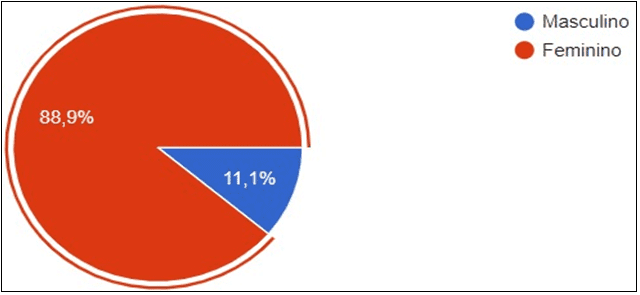
Regarding the age group of the participants, 88.9% of the respondents are between 30 and 59 years old, 5.6% between 18 and 29 years and 5.6% are 60 years or older, as shown in Graph 2.
Graph 2.
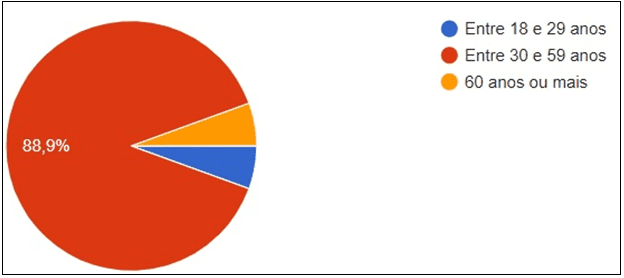
Regarding the marital status of the sample surveyed, 61.1% of the respondents are married, 16.7% are single, 11.1% divorced, 5.6% widowed and 5.6% declared to be in a stable union. The research also identified the participants by race, in this variable it is identified that 50% declared themselves white, 44.4% brown and 5.6% are black.
The instrument also identified issues related to family composition and purchasing power of participants based on monthly family income. 77.8% have children and 22.2% do not. Of the participants who have children, 92.9% have up to 02 children and 7.1% have only 01 children.
Regarding the monthly family income of the respondents, it is identified that the majority of the sample 61.1% claim to have a monthly family income of 3 to 4 minimum wages. 33.3% reported income from 5 to 6 monthly minimum wages and 5.6% have a monthly family income of 1 to 2 minimum wages. These data are described in Graph 3.
Graph 3.
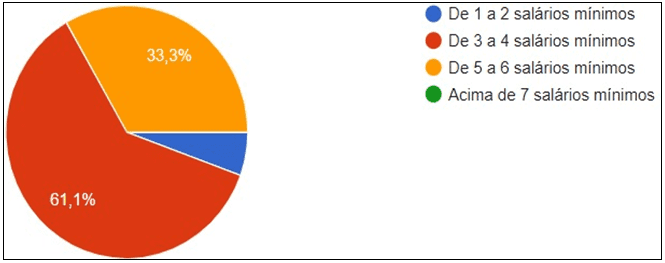
77.8% of the respondents have the title of complete specialist, 11.1% did not complete specialization and 11.1% have only higher education. When trying to identify the amount of working time that the participant has in education, it is identified that 83.3% work over 11 years in the area. 11.1% from 2 to 5 years and 5.6% have 6 to 10 years of professional experience, as shown in graph 4.
Graph 4.
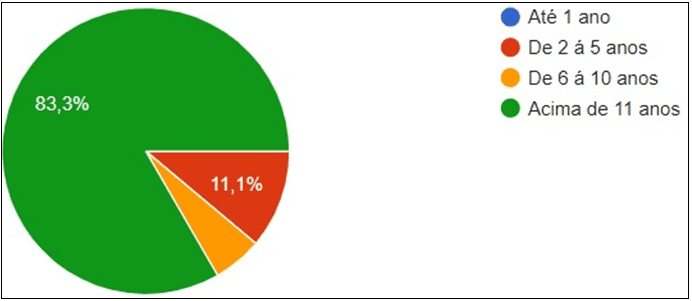
In order to complete the statistical presentation of the socio-demographic data of the sample studied, the instrument allowed to identify the weekly workload, which shows that 61.1% have a weekly hourly load of 40 hours. 27.8% have a workload of 60 hours per week, 5.6% of participants have 20 and 30 hours, respectively.
Based on the statistical data presented so far, it is possible to identify that the profile of the majority of the participants in this study are women (88.9%) white and brown (summed up equivalent to 94.4% of the general sample), aged between 30 and 59 years (88.9%), married (61.1%), with 2 children (92.9%), working in the area of education for more than 11 years (83.3%) with a specialist level of education (77.8%) and family purchasing power between R$ 3,135.00 to R$: 4,180.00 reais/month, for this, it is dedicated to a workload of 40 hours per week (61.1%).
3.1 CENTRAL AND PERIFERICO NUCLEUS OF SOCIAL REPRESENTATIONS: THE QUALITATIVE ANALYSIS OF DISCOURSE
From the technique of free evocations in which the participants (N=18) produced five words or expressions to the inducing term “psychological illness of the teacher”, a total of 90 evocations were found. In this first stage, the evoked expressions with an order of 3.00 and minimum frequency of 2.00%, considering the degree of importance and relevance for the study, can be observed in Figure 1.
Figure 1

The evocations tiredness, anxiety, stress, sadness, depression, fear, nervousness and overload, are elements present in the central nucleus of the representation, translating the collective memory, the socio-historical conditions and the values of the group, having as function to generate the basic meaning of the representation, because they appear more frequently and in the first orders of evocation from the inducing term.
These findings are confirmed in the studies by Lima and Filho (2009) which, in their studies, bring that the main complaints related to the mental health of teachers were overload, mental tiredness, stress, anxiety, frustration, nervousness, anguish, insomnia and depression. Gomes (2002), in his study that aimed to verify how the school contributed to the illness of teachers, highlighted health problems such as: agitation, stress, irritation, malaise, anxiety, tension, nervousness, irritability, depression, anguish, exhaustion, sleep disturbance and overload.
Given the identified data, it is possible to notice that the terms that make up the central nucleus are intrinsically related to the internal symptoms experienced by the teacher. Anxiety is defined as a vague and unpleasant feeling of fear, apprehension, tension and discomfort coming from an anticipation of danger, which is accompanied by physical manifestations. It becomes pathological, when feelings are exaggerated or disproportionate in relation to the stimulus and when they interfere with the quality of life of the individual (CASTILLO et al., 2000).
The expression stress can be conceptualized as a process in which the individual understands that the demands of work and daily life are stressful, by overcoming their coping repertoire, provoking negative reactions (PASCHOAL; TAMAYO, 2004). And according to Lima and Filho (2009) stress is a general state of physiological tension and maintains a direct relationship with the demands of the environment. Stress can cause physical and psychological symptoms, among them are: tiredness, nervousness, irritability, anxiety, sadness, insomnia, anger, emotionality, depression and isolation (VALLE et al., 2011).
The sadness identified in the teacher’s speech seems to evidence one of the symptoms of depressive disorder, since it is possible to identify that of the 11 professionals diagnosed with psychological illness, 5 of them report depression. Depression can be defined as a complex of sentimental, cognitive and behavioral deviations. Within these deviations, it is possible to identify a very characteristic change in mood and other symptoms. Regarding mood, the authors mention, among them, sadness, loneliness and apathy (BECK; ALFORD, 2011).
The evocations collection, discouraged, lack of time, wear, fatigue, demotivation and salary, are components present in the peripheral nucleus of the representation and translate the external factors that imply in the performance of the teaching professional. These representations allow the mobility and flexibility of representation, allowing the integration of the individual experiences and histories of the subjects, apprehension of the heterogeneity of the group and contradictions, and its functions consist, in current and daily terms, in the adaptation to concrete reality and in the differentiation of the content of the representation, in addition to its character of protection of the central nucleus (ABRIC, 1994).
The expressions of discouragedness, wear and fatigue may be related to the diagnoses of the professionals studied, because they are diagnostic criteria in disorders evidenced by the sample surveyed, such as depression, anxiety and panic syndrome. Here it is worth mentioning that, because it is a work environment, it is important to reinforce burnout syndrome, which, although not presented by the sample, is characterized by the presence of symptoms such as fatigue, demotivation, discouragedness, wear, devaluation, dissatisfaction, distrust, irritability, aggressiveness, isolation, exhaustion, impatience, sleep disorders and also the loss of interest in work (ASSIS, 2006).
According to studies conducted by Siqueira and Ferreira (2003) and Paparelli (2009) many of the psychosomatic symptoms presented by teachers arise from aspects such as low wages and overload. Corroborating, Valle et al. (2011) in their studies on the factors related to the symptoms of stress and sleep disorder of teachers, indicate that elements such as overwork, low salaries and lack of time interfere in the teacher’s health.
The word wear and tear can be understood as the loss of potential or effective capacity, body and psychic (LAURELL; NOGUEIRA, 1989, apud PAPARELLI, 2009). According to the doctor Ramiro Stelmach the teacher wear comes from a system that does not work, because in it the teacher is poorly paid, has little time to take care of health and to rest (WEBLER, 2006). Therefore, the wear iness in the participants’ work environment seems to be associated with the factors to which professionals are submitted, which may be a determining factor for the onset of psychological diseases.
4. CONCLUSION
The research proposed to verify how the social representations of teachers sick from elementary school are being constructed and shared. And as a way to identify the central and peripheral nuclei of social representations, the technique of free evocation was used. The first brings the elements: collection, discouragedness, lack of time, wear, fatigue, demotivation and salary.The second, that is, the peripheral nucleus points out the terms: tiredness, anxiety, stress, sadness, depression, fear, nervousness and overload.
In this sense, it is worth mentioning that the evocations of the peripheral nucleus of this research relate to external aspects, that is, they are elements that can be modified from interventions in the environment or in school culture. On the contrary, the evocations present in the central nucleus are linked to the internal aspects of the subject/teacher, that is, they are less flexible elements and that, in order to have any change in social representations, these aspects must be worked individually and singularly.
Therefore, it is oriented that the school community, but not only this one, provide security, space for debate, social and economic recognition to teachers, as well as the reduction of activities performed outside the work day and, consequently, increased time for self-care, from a biopsychosocial conception.
This study provided important reflections for the researcher, since it allowed new experiences and an academic, theoretical and methodological expansion in the field of school psychology in conjunction with the theory of social representations. Moreover, it is important to highlight that such experiences have opportunistic knowledge beyond that acquired in the position of student and daughter of a teacher.
It is possible to affirm that the research answered the initial question that aimed and guided this study, however, it aroused a range for new provocations and concerns, so it is oriented that research is carried out that are articulated between professional practice and the work conditions of the teacher as suggested here, reflecting on the implications of this, in the quality of life of the professional.
REFERENCES
ABRIC, J. C. Pratiques e représentations sociales. Paris: PUF, 1994.
ALMEIDA, Leda; SANTOS, Maria. Diálogos com a teoria das representações sociais. Editora UFPE, 2005.
ASSIS, Fernanda Bernardes. Síndrome de Burnout: um estudo qualitativo sobre o trabalho docente e as possibilidades de adoecimento de três professoras das séries iniciais. 2006, 146 folhas. Dissertação (Mestrado, Psicologia aplicada). Universidade Federal de Uberlândia. 2006. Disponível em: <https://repositorio.ufu.br/handle/123456789/17172>. Acessado em: 19/06/2020.
BATISTA, Jaqueline B. V. et al. O ambiente que adoece: condições ambientais de trabalho do professor do ensino fundamental. Cad. Saúde Colet. Rio de Janeiro, v.18, n.2, 2010. Disponível em: <http://www.cadernos.iesc.ufrj.br/cadernos/images/csc/2010_2/artigos/CSCv18n2_234-242.pdf>. Acessado em: 20/02/2020.
BECK, Aaron; ALFORD, Brad. Depressão: causas e tratamentos. 2º edição. Editora Artmed, 2011.
BRASIL. Lei nº 11.274, de 6 de feveriro de 2006. Estabelece as diretrizes e bases da educação nacional, dispondo sobre a duração de 9 (nove) anos para o ensino fundamental, com matrícula obrigatória a partir dos 6 (seis) anos de idade. Disponível em: <http://www.planalto.gov.br/ccivil_03/_Ato2004-2006/2006/Lei/L11274.htm>. Acessado em: 27/02/2020.
BRASIL. Lei nº 11.494, de 20 de junho de 2007. Regulamenta o Fundo de Manutenção e Desenvolvimento da Educação Básica e de Valorização dos Profissionais da Educação – FUNDEB. Disponível em: <http://www.planalto.gov.br/ccivil_03/_ato2007-2010/2007/Lei/L11494.htm>. Acessado em: 27/02/2020.
BRASIL. Lei nº 4.024, de 20 de dezembro de 1961. Fixa as Diretrizes e Bases da Educação Nacional. Disponível em: <https://www2.camara.leg.br/legin/fed/lei/1960-1969/lei-4024-20-dezembro-1961-353722-publicacaooriginal-1-pl.html>. Acessado em: 27/02/2020.
BRASIL. Lei nº 9.394, de 20 de dezembro de 1996. Estabelece as diretrizes e bases da educação nacional. Disponível em: <https://portal.facema.edu.br/cpa-doc/LDB-.pdf>. Acessado em: 27/02/2020.
CASTILLO, Ana Regina et al. Transtorno de ansiedade. Rev. Bras. Psiquiatr. São Paulo, v.22, s.2, 2000. Disponivel em: <https://www.scielo.br/scielo.php?pid=S1516-44462000000600006&script=sci_arttext>. Acessado em: 14/07/2020.
COUTINHO, Maria; BÚ, Emerson. A técnica de associação livre de palavras sobre o prisma do software tri-deux-mots (version 5.2). Revista campo do saber, v.3, n.1, 2017. Disponível em <http://periodicos.iesp.edu.br/index.php/campodosaber/article/view/72>. Acessado em: 28/01/2020.
DEJOURS, C. Psicodinâmica do trabalho: contribuições da escola dejouriana à análise da relação prazer, sofrimento trabalho. São Paulo: Atlas, 1994.
DELCOR, Núria Serre et al. Condições de trabalho e saúde dos professores da rede particular de ensino de Vitória da Conquista, Bahia, Brasl. Cadernos de saúde pública. Rio de Janeiro, v.20, n.1, 2004. Disponível em: <http://www.scielo.br/scielo.php?pid=S0102-311X2004000100035&script=sci_arttext>. Acessado em: 25/01/2020.
DOISE, Willem. Da psicologia social à psicologia societal. Psicologia: teoria e pesquisa. Brasília, v.18, n.1, 2002. Disponível em: <http://www.scielo.br/scielo.php?pid=S0102-37722002000100004&script=sci_arttext&tlng=pt>. Acessado em: 28/01/2020.
GASPARINI, Sandra Maria et al. O professor, as condições de trabalho e os efeitos sobre sua saúde. Educação e pesquisa. São Paulo, v.31, n.2, 2005. Disponível em: <http://www.scielo.br/scielo.php?pid=S1517-97022005000200003&script=sci_arttext>. Acessado em: 28/01/2020.
GOMES, Luciana. Trabalho multifacetado de professores/as: a saúde entre limites. 2002, 127 folhas. Dissertação (Mestrado, Ciências na área de saúde pública). Escola Nacional de Saúde Pública – ENSP do Rio de Janeiro. 2002. Disponível em: <https://www.arca.fiocruz.br/handle/icict/5219>. Acessado em: 28/01/2020.
JODELET, Denise. Representações sociais: um domínio em expansão. UERJ: 2001.
LIMA, Maria de Fátima Evangelista Mendonça; FILHO, Dario de Oliveira Lima. Condições de trabalho e saúde do/a professor/a universitário/a. Ciências e Cognição. v.14, n.3, 2009. Disponível em <http://cienciasecognicao.org/revista/index.php/cec/article/view/253>. Acessado em: 17/06/2020.
MONTEIRO, Rui Ander Costa et al. Lei e diretrizes e bases da educação nacional: o porquê e seu contexto histórico. Revista Eletrônica de Educação. v. 5, n. 2, 2011. Disponível em: <http://www.reveduc.ufscar.br/index.php/reveduc/article/view/225/142>. Acessado em: 27/02/2020.
MORENO, Jean Carlos. História na Base Nacional Comum Curricular: déjà vu e novos dilemas no século XXI. História e Ensino. Londrina, v. 22, n. 1, 2016. Disponível em: <http://www.uel.br/seer/index.php/histensino/article/view/26158>. Acessado em: 27/02/2020.
OLIVEIRA, Oséias Santos et al. Perspectivas na consolidação do sistema de ensino brasileiro: o desenho da democratização proposto nas leis de diretrizes e bases – Leis 4.024/61 e 9.394/96. Jornal de politicas educacionais. v.4, n.7, 2010. Disponível em: <https://revistas.ufpr.br/jpe/article/view/21862/14298>. Acessado em: 27/02/2020.
PAPARELLI, Renata. Desgaste mental do professor da rede pública de ensino: trabalho sem sentido sob a politica de regularização de fluxo escolar. 2009. 194 folhas. Tese (Doutorado, Psicologia). Instituto de Psicologia, Universidade de São Paulo. 2009. Disponível em: <https://www.teses.usp.br/teses/disponiveis/47/47134/tde-07122009-145916/publico/tesepaparelli2009.pdf>. Acessado em: 17/06/2020.
PASCHOAL, Tatiane; TAMAYO, Álvaro. Validação da escala de estresse no trabalho. Estudos de Psicologia. Natal, v.09, n.1, 2004. Disponível em <https://www.scielo.br/scielo.php?pid=S1413294X2004000100006&script=sci_arttext&tlng=pt>. Acessado em: 17/06/2020.
REY, Fernando. As representações sociais como produção subjetiva: seu impacto na hipertensão e no câncer. Revista Redalyc. São Paulo. v.8, n.2, 2006. Disponível em: <https://www.redalyc.org/articulo.oa?id=193818634002>. Acessado em: 23/01/2020.
SÁ, Celso Pereira. Representações sociais: teoria e pesquisa do núcleo central. Temas em psicologia. Ribeirão Preto, v.4, n.3, 1996. Disponível em: <http://pepsic.bvsalud.org/scielo.php?script=sci_arttext&pid=S1413-389X1996000300002>. Acessado em: 25/01/2020.
SAVIANI, Dermeval. Educação escolar, currículo e sociedade: o problema da Base Nacional Comum Curricular. Revista Movimento. Rio de Janeiro, n.3, 2016. Disponível em: <https://periodicos.uff.br/revistamovimento/article/view/32575/18710>. Acessado em: 25/02/2020.
SILVA, Flávia Gonçalves. O professor e a educação: entre o prazer, o sofrimento e o adoecimento. 2007. 419 folhas. Tese (Doutorado, Psicologia da Educação). Pontifícia Universidade Católica de São Paulo. 2007. Disponível em: <https://tede2.pucsp.br/handle/handle/16308>. Acessado em: 28/01/2020.
SIQUEIRA, M.J.T.S; FERREIRA, Edirê. Saúde das professoras das séries iniciais: o que o gênero tem a ver com isso? Psicologia: ciência e profissão. Brasília, v.23, n.3, 2003. Disponível em: <http://www.scielo.br/scielo.php?pid=S1414-98932003000300011&script=sci_arttext>. Acessado em: 13/02/2020.
VALLE, Luiza Elena Ribeiro; REIMÃO, Rubens; MALVEZZI, Sigmar. Reflexões sobre Psicopedagogia, estresse e distúrbios do sono do professor. Revista psicopedag. São Paulo. v.28, n.87, 2011. Disponível em <http://pepsic.bvsalud.org/scielo.php?script=sci_arttext&pid=S0103-84862011000300004>. Acessado em: 17/06/2020.
WACHELKE, João; WOLTER, Rafael. Índices complementares para o estudo de uma representação social a partir de evocações livres: raridade, diversidade e comunidade. Revista Psicologia: Teoria e Prática. São Paulo-SP, v.15, n.2, 2013. Disponível em: <http://editorarevistas.mackenzie.br/index.php/ptp/article/view/4363>. Acessado em: 28/01/2020.
WEBLER, Rita Melânia. O mal-estar e os riscos da profissão docente. CCSA- Em Revista. 2006. Disponível em: <http://sistema.app.com.br/portalapp/uploads/opiniao/CCSA-%20Em%20Revista%20_2_.pdf> Acessado em: 04/09/2020.
[1] Master’s degree in Clinical and Health Psychology, Postgraduate in Educational Psychology, Post-Graduate degree in Psychological Evaluation, Graduated in Psychology.
Submitted: September, 2020.
Approved: April, 2021.

